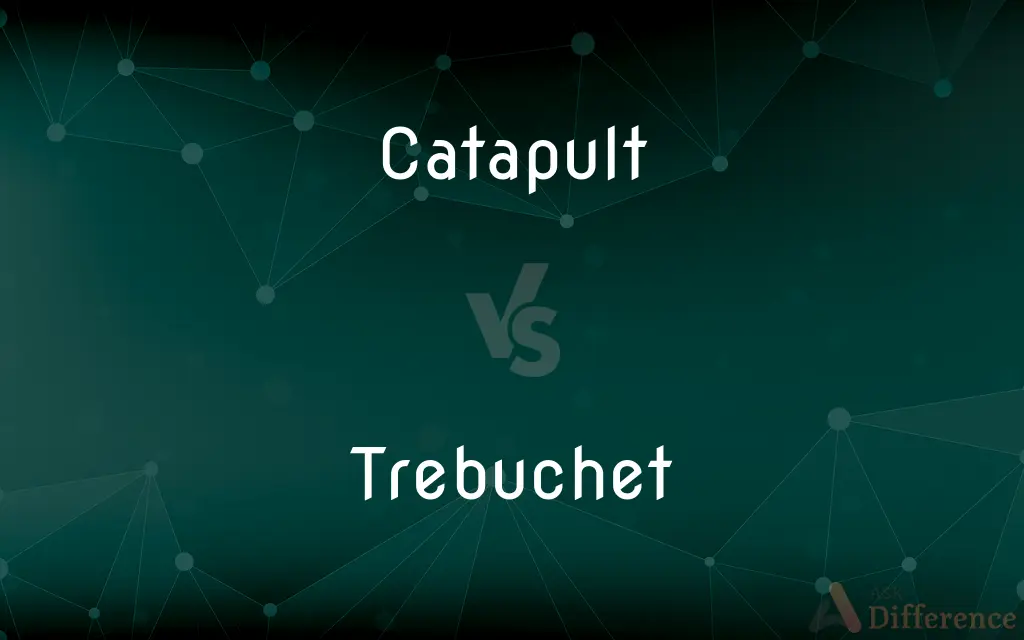Catapult vs. Trebuchet — What's the Difference?
By Tayyaba Rehman — Updated on September 22, 2023
A catapult is a general term for siege machines that throw objects, while a trebuchet is a specific type of gravity-powered catapult using a long arm and counterweight. Both were used in ancient warfare.

Difference Between Catapult and Trebuchet
Table of Contents
ADVERTISEMENT
Key Differences
Catapults and trebuchets, both powerful siege engines, have played critical roles in warfare, especially during ancient and medieval times. While the term "catapult" often evokes images of a device flinging objects over distances, it's a broad term encompassing various machines, such as ballistae and onagers. The trebuchet, on the other hand, is a specific design of a catapult, known for its distinct mechanism using a counterweight and a long arm.
The operational principle of a catapult is based on tension or torsion. These machines store energy in twisted ropes or in a bent piece of wood, releasing this energy to propel a projectile. Trebuchets operate on a different principle, utilizing gravity. They have a long arm, with a projectile on one end and a counterweight on the other. When the trebuchet is released, the counterweight falls, propelling the projectile from the sling at the opposite end with significant force.
A catapult's design is often more compact and versatile, allowing for variations in size and structure. This flexibility made them suitable for different military strategies and terrains. The trebuchet, with its towering frame and heavy counterweight, was often larger and required a more fixed setup, but it offered unparalleled power and accuracy in return.
Historically, while catapults saw extensive use in various ancient civilizations, trebuchets reached their pinnacle during the medieval period. The sheer force a trebuchet could exert made it particularly effective against fortified structures. Both, however, have left an indelible mark on the history of warfare, showcasing human ingenuity in crafting tools of siege.
Comparison Chart
Operational Principle
Tension or torsion
Gravity
ADVERTISEMENT
Design
Compact, versatile
Larger with a long arm and counterweight
Usage Era
Ancient civilizations
Primarily medieval
Energy Source
Twisted ropes or bent wood
Falling counterweight
Primary Use
Varied warfare strategies and terrains
Siege of fortified structures
Compare with Definitions
Catapult
Historically used in various ancient civilizations.
Ancient Greeks improved catapult designs for enhanced battlefield efficiency.
Trebuchet
Renowned for its power and accuracy.
The trebuchet could accurately hurl boulders against castle walls.
Catapult
A device storing energy in tension or torsion for propulsion.
The twisted ropes in the catapult provided the necessary tension for launching projectiles.
Trebuchet
A specific and distinct type of catapult design.
Among all siege engines, the trebuchet was uniquely efficient in breaching defenses.
Catapult
A broad term for multiple siege engine designs.
The ballista is a type of catapult that shoots bolts.
Trebuchet
Primarily used during the medieval period.
Medieval castles often faced the threat of trebuchet sieges.
Catapult
A catapult is a ballistic device used to launch a projectile a great distance without the aid of gunpowder or other propellants – particularly various types of ancient and medieval siege engines. A catapult uses the sudden release of stored potential energy to propel its payload.
Trebuchet
A gravity-powered catapult with a counterweight.
The trebuchet's design allowed it to launch heavier projectiles over greater distances.
Catapult
Any of various military machines used for hurling missiles, such as large stones or spears, in ancient and medieval times.
Trebuchet
Recognized for its long arm and sling mechanism.
At the end of the trebuchet's arm, a sling provided additional leverage for launching.
Catapult
A mechanism for launching aircraft at a speed sufficient for flight, as from the deck of a carrier.
Trebuchet
A trebuchet (French: trébuchet) is a type of catapult that uses a long arm to throw a projectile. It was a common powerful siege engine until the advent of gunpowder.
Catapult
A slingshot.
Trebuchet
A medieval catapult for hurling stones or other heavy projectiles, often by means of a sling at the end of a long, counterweighted, swinging arm.
Catapult
To hurl or launch from a catapult.
Trebuchet
A medieval siege engine consisting of a large pivoting arm heavily weighted on one end.
Medieval trebuchets are said to have been capable of launching 90-kg projectiles over distances of more than 300 meters.
Catapult
To hurl or launch by means other than a catapult
The blast catapulted bricks across the street.
Trebuchet
A torture device for dunking suspected witches by means of a chair attached to the end of a long pole.
Catapult
To bring suddenly into prominence
The film catapulted her into fame.
Trebuchet
To shoot with a trebuchet.
Catapult
To be catapulted or hurled
The rider catapulted over the handlebars.
Trebuchet
A cucking stool; a tumbrel.
Catapult
To jump or spring
She catapulted over the gate.
Trebuchet
A military engine used in the Middle Ages for throwing stones, etc. It acted by means of a great weight fastened to the short arm of a lever, which, being let fall, raised the end of the long arm with great velocity, hurling stones with much force.
Catapult
A device or weapon for throwing or launching large objects.
Trebuchet
A kind of balance for weighing.
Catapult
A mechanical aid on aircraft carriers designed to help airplanes take off from the flight deck.
Trebuchet
Medieval artillery used during sieges; a heavy war engine for hurling large stones and other missiles
Catapult
(UK) A slingshot.
Catapult
An instance of firing a missile from a catapult.
Catapult
(figuratively) An instance of firing something, as if from a catapult.
Catapult
(transitive) To fire a missile from a catapult.
Catapult
(transitive) To fire or launch something, as if from a catapult.
Catapult
(transitive) To increase the status of something rapidly.
The candidate selection for running mate has catapulted her to the national scene.
Catapult
(intransitive) To be fired from a catapult or as if from a catapult.
Catapult
(intransitive) To have one's status increased rapidly.
She catapulted to the national scene following her selection by the candidate.
Catapult
An engine somewhat resembling a massive crossbow, used by the ancient Greeks and Romans for throwing stones, arrows, spears, etc.
Catapult
A forked stick with elastic band for throwing small stones, etc.
Catapult
A plaything consisting of a Y-shaped stick with elastic between the arms; used to propel small stones
Catapult
A device that launches aircraft from a warship
Catapult
Medieval artillery used during sieges; a heavy war engine for hurling large stones and other missiles
Catapult
Shoot forth or launch, as if from a catapult;
The enemy catapulted rocks towards the fort
Catapult
Hurl as if with a sling
Catapult
A siege machine designed to throw objects at a distance.
The Romans used the catapult to hurl stones at enemy fortifications.
Catapult
Often smaller and more versatile than trebuchets.
The army deployed several catapults to adapt to the changing terrain.
Common Curiosities
Are trebuchets a type of catapult?
Yes, a trebuchet is a specific design of a catapult.
Which is more powerful, a catapult or trebuchet?
Generally, trebuchets were more powerful due to their counterweight mechanism.
What made the trebuchet so effective in sieges?
The trebuchet's power, range, and accuracy made it effective against fortifications.
What kind of energy does a catapult use?
Catapults typically use tension or torsion energy.
How does a trebuchet release its projectile?
A trebuchet uses a falling counterweight to propel its projectile.
Were catapults used in ancient Rome?
Yes, ancient Romans used various catapult designs in warfare.
Is a ballista considered a catapult?
Yes, a ballista is a type of torsion-powered catapult.
Share Your Discovery

Previous Comparison
Atypical vs. Untypical
Next Comparison
Atom vs. CellAuthor Spotlight
Written by
Tayyaba RehmanTayyaba Rehman is a distinguished writer, currently serving as a primary contributor to askdifference.com. As a researcher in semantics and etymology, Tayyaba's passion for the complexity of languages and their distinctions has found a perfect home on the platform. Tayyaba delves into the intricacies of language, distinguishing between commonly confused words and phrases, thereby providing clarity for readers worldwide.















































